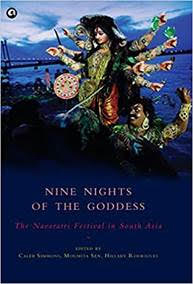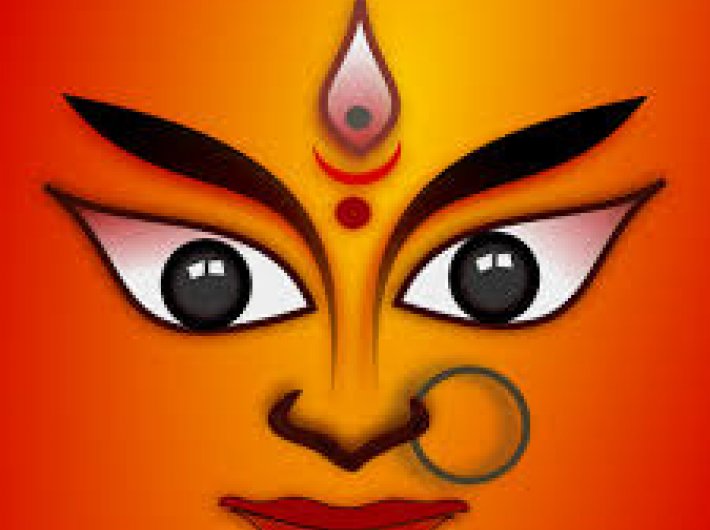An excerpt from ‘The Nine Nights of the Goddess’: On the textual history of the festival
 Hindus are celebrating the Navaratri festival these days. Known also as Navarātra, Mahānavamī, Durgā Pūjā and Dasarā, the nine-night festival is celebrated at different times of the year, in different traditions. Though the one beginning about a month before the Diwali is the main festival (culminating in the Dussehra), the one observed now – called Chaiti Navaratri – is no less significant for the faithful.
Hindus are celebrating the Navaratri festival these days. Known also as Navarātra, Mahānavamī, Durgā Pūjā and Dasarā, the nine-night festival is celebrated at different times of the year, in different traditions. Though the one beginning about a month before the Diwali is the main festival (culminating in the Dussehra), the one observed now – called Chaiti Navaratri – is no less significant for the faithful.
‘Nine Nights of the Goddess: The Navaratri Festival in South Asia’ [published in India by Aleph Books in 2019] is a collection of scholarly essays on various facets of the festival. It’s edited by Caleb Simmons, Assistant Professor of Religious Studies at the University of Arizona, Moumita Sen, a Postdoctoral Fellow at the University of Oslo, Norway, and Hillary Rodrigues, Professor of Religious Studies at the University of Lethbridge, Canada.
When the Chaitra Navaratri is on, an excerpt from the introduction of this volume, written by Caleb Simmons and Moumita Sen, includes a textual history of Navarātri – various scriptural and other sources of the tradition. Here is an extract from that section:
[Textual histories of Navarātri]
Within the Purāṇic tradition, references to Navarātri and its attendant rituals steadily increase over time. One of the earliest discussions of the great autumn festival to the goddess comes from the Mārkaṇḍeya Purāṇa. Within the text is a smaller thirteen-chapter section commonly known as the Devī Māhātmya (also known as Durgāsaptaśatī and Caṇḍīpāṭha, c. sixth-century CE) that tells of the exploits of the Goddess as she embodies to fight demons for the sake of the gods and the maintenance of the cosmos. In the second of three episodes, the text relates the story of the manifestation of the Goddess from the brilliance of the gods and her subsequent defeat of the buffalo-demon Mahiṣa. It is, however, in the last episode that Navarātri is specifically mentioned. In this portion of the text the Goddess has just defeated the demons Śumbha and Niśumbha, which prompts praise and adulation from the rest of the pantheon, specifically exalting her role as the giver of boons. Beginning in chapter 11, the Goddess replies to their praise with a monologue in which she prescribes the most efficacious forms of worship for those seeking boons. In chapter 12, she transitions to a discussion of the Devī Māhātmya itself and proclaims that anyone who hears it recited during the great pūjā of autumn (śaratkāle mahāpūjā) will be healthy and wealthy with grain and with children (Devī Māhātmya 12.12). The text continues to be important for Navarātri not only for its narration of the deeds of the Goddess, but just as the text prescribes it continues to be chanted throughout the nine nights of the Goddess.
The Devī Purāṇa is perhaps the earliest of the Śākta (Goddess-oriented) Purāṇas, dating between the sixth and ninth centuries (Hazra 1963, 71–77). This text, unlike the Devī Māhātmya, explicitly connects the slaying of Mahiṣāsura and Navarātri and describes the proper celebration of the festival. The story of Mahiṣāsura, however, diverges from the story with which most are familiar. In the text’s second pada, it narrates the rise of the demon named Ghora. After Ghora is deluded by his wife because of her conversion to a Digambara sect of Jainism, the demon devolves into sinful acts and in the twentieth chapter assumes the form of a buffalo (Mahiṣa). In the subsequent chapter, Ghora-as-Mahiṣa is slain by the Goddess, after which Navarātri is established. The following chapters (chapters 22–23) discuss the proper timing and performance of the rituals during the nine nights of Mahānavamī. Later in chapter 28, the text returns to the Navarātri rites and enumerates their benefits to the practitioner.
The Kālikā Purāṇa (c. tenth to twelfth centuries) reserves an entire chapter (chapter 60) to the proper celebration of the autumnal festival of Navarātri. In addition to describing the proper mantra and Tantras, the text also explicitly connects the Rāmāyaṇa narrative and the story of
Mahiṣa with Navarātri. According to the text, the Goddess watched the first seven days of the battle between the armies of Rāma and Rāvaṇa, eating the flesh of the fallen at night. On the ninth day of the battle, Rāma conducted a special pūjā to Durgā after which she caused Rāvaṇa to be slain. The text uses this narration to solicit kings to conduct the same pūjā to strengthen their armies (Kālikā Purāṇa 60.43). Later in the same chapter, the Kālikā Purāṇa narrates the Mahiṣa story but adds another portion in which Mahiṣāsura converts and takes refuge in the Goddess before she kills him (Kālikā Purāṇa 60.101–02). Going even further, the text equates Mahiṣa to an incarnation of the deity Śiva due to a curse from the sage Kātyāyana (Kālikā Purāṇa 60.151–53). Despite or perhaps due to its strong Śākta message, the Kālikā Purāṇa has remained an influential ritual text and is even the ritual śāstra used to determine issues of practice for pandits of the Mysore court.
The Devī Bhāgavata Purāṇa (c. eleventh to twelfth centuries) is roughly contemporaneous with the Kālikā Purāṇa and likewise places the celebration of Navarātri within both ritual and narrative contexts throughout the twenty-sixth to thirtieth chapters of its third book. In the narrative descriptions, however, the Devī Bhāgavata Purāṇa places Navarātri in a broader mythic context in which the pūjā to the Goddess not only gave Rāma his victory over Rāvaṇa but was also enacted by other deities ensuring victories for Indra over the demon Vṛtra, Śiva over Tripura, and Viṣṇu over Madhu, truly expanding the cosmic scope and efficacy of the festival (Devī Bhāgavata Purāṇa 3.30.25–26). Further, in the seventh book (chapters 31–40) of the Devī Bhāgavata Purāṇa, a philosophical treatise called the Devī Gītā expounds upon Śākta thought in a style that mimics the famous Bhagavad Gītā. In the Devī Gītā, the Goddess tells the mountain Himālāya the secrets of her worship, among which she lists both the spring and autumn Navarātris among the most effective celebrations of her power (Devī Gītā 8.42; Brown 1998, 251). In addition to the narrative and philosophical developments, Devī Bhāgavata Purāṇa expands the ritual prescriptions for Navarātri, especially in regard to the austerities of the festival’s vrata (fast), which has become a major element of many celebrations of the festival (Hazra 1987, 242).
Just as the Purāṇic tradition has maintained portions of the Navarātri tradition, the Navarātri tradition has preserved otherwise lost Purāṇic knowledge. The only remaining portions of the lost Śākta Purāṇa Bṛhannandikeśvara Purāṇa is known to us through twenty-five lines that
were quoted in Raghunandana’s text on the practice of Durgā Pūja, the Durgāpūjātattva (also known as Durgotsavatattva, c. sixteenth century) (Hazra 1963, 466–69). In the passage quoted by Raghunandana, it is said that the Goddess should be worshipped in earthen images and in the form of nine plants (nava patrikā) and should be bathed (mahāsnāna) with various ritual elements. He also describes ritual sacrifice of he-goats and buffaloes and the performance of fire rituals (homa). He concludes that the ninth day is to be celebrated with sacrifices, music, and general merry-making.
Beyond these texts, there are many more Sanskrit narrative texts that reference Navarātri and ritual treatises that discuss the proper celebration of the festival (e.g., Durgotsavaviveka of Śūlapāṇi, Durgāpūjāprayogatattva of Raghunandana, Durgābhaktitaraṅginī of Vidyāpati, Navarātrapradīpa of Vināyaka, and Durgotsavapaddhati of Udayasiṃha; see Hazra 1963, 155). In addition to these, there are innumerable traditional narratives, prescriptions, and ritual treatises in vernacular languages throughout South Asia, not to mention the emerging visual media (film and television) and social media that are constantly recording and recreating the tradition today.
[Excerpt reproduced with the permission of the publishers.]


